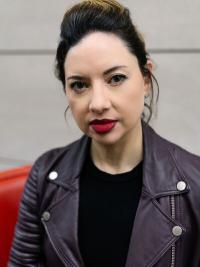About
The community of practice on movement engages the multifaceted aspects of human migration and mobility — this year's cohort will explore the topic of immigration. Communities of practice foster community among the teacher participants and enhance the learning experience of participants by cultivating group-centered relationships over the course of the year through multiple meetings, starting with online webinars and continuing with an experiential-learning field trip and on-campus, curriculum-development workshop.
Curriculum
Who are we, and how do our names, faces and stories of home and place affect our understanding of migration to the United States today? What are some of the risks and rewards involved in teaching about migration to young people? Our first module will take a long historical approach to understand what it means to be an “American.” We’ll examine who is invited — and who is excluded — to participate in the national project and be introduced to a selection of free tools and resources available to educators in this field.
How can we make sense of migration narratives when there are so many conflicting reports and opinions about who belongs in the United States, and who should be excluded? We’ll analyze mainstream news reporting to understand how different media outlets report on this topic.
Our third module offers a participant-focused session that dives into U.S. histories of intolerance, while surveying national and local programs and centers facilitating, supporting and promoting the integration efforts of individuals and communities.
This module looks at Ohio’s history of population, migration and narratives of inclusion and exclusion to understand how the state has developed ideas of territoriality and belonging.
A diaspora is a dispersion of a formerly-concentrated group of people sharing cultural similarities and homelands who have been compelled to displace and live in geographically-distant areas of the world. In module five, we examine diasporic cultural expression and the artistic practices that help create and incentivize placemaking and cultural pride. We’ll read The Distance Between Us: A Memoir by Reyna Grande and When I Get Older: The Story behind "Wavin' Flag" by K’NAAN to explore various pedagogical possibilities of memoir and music in the study of displaced peoples.
It’s an all-too-common Columbus story: Popular restaurants offering Mexican-inspired fare veer into the unsavory territory of cultural misappropriation. We’ll go on an alternative taco tour of migrant-owned local businesses to sample heritage cuisine, interrogate tropes in the culinary marketplace and consider how food can serve as a scaffolding for cultural border crossing and discovery.
About the Facilitator

Paloma Martinez-Cruz teaches Latinx Cultural Studies in the areas of performance and popular culture; decolonial methods and practices; and Latin American and Latinx gender studies and feminisms. She is the author of Trust the Circle: The Resistance and Resilience of Rubén Castilla Herrera Food Fight! (2023), Millennial Mestizaje Meets the Culinary Marketplace (2019) and Women and Knowledge in Mesoamerica: From East L.A. to Anahuac (2011). She is the editor of A Handbook for the Rebel Artist in a Post-Democratic Society by Guillermo Gómez-Peña and Saúl García-López (Routledge). An interdisciplinary scholar-artist, she publishes poetry and fiction, directs and performs with the Taco Reparations Brigade performance troupe and coordinates Onda Latinx Ohio, an arts initiative showcasing Latinx arts from the Midwest and beyond.
Additional Information
If you’re a district leader or an educator in any Central Ohio district, please complete the nomination/application webform.
There is no cost for educators to participate. The institute offers each educator a $500 stipend and provides textbooks and other resources. Stipends will be disbursed following successful completion of the institute. Educators are also eligible for Continuing Education Units.
Which educators would benefit from participating in the DSI?
Any K-12 educator would benefit from participation. Institute seminars and workshops are at heart of the program curriculum and are led by scholars from The Ohio State University’s College of Arts and Sciences who have expertise in history, literature, art, music and performance. Recognizing the value of practice, the institute also brings in teaching experts (to share pedagogical techniques) and multicultural curriculum developers (to provide instruction on complementing and supplementing State of Ohio standards pertaining to difficult subjects).
How much does the institute cost?
There is no cost to participate. The institute offers each educator a modest stipend as well as textbooks, parking and field trip food and travel. Stipends are disbursed following successful completion of the institute.
How does the district nominate an educator to participate?
District leadership may nominate educators by completing the webform and answering some brief questions.
Can educators volunteer without the permission of their district leaders?
Yes, educators may nominate themselves using the webform. However, unnominated educators must include a letter of recommendation or concurrence from their district DEI coordinator or school principal.
How long and how often are the institute sessions?
Programming consists of 30 hours of engagement. It includes an orientation session (January); five three-hour Saturday seminars (monthly); and an in-person experiential-learning field trip and workshop (June).
How do educators earn credit for participation?
Upon successful completion of whole institute, educators are awarded a certificate and verification of contact hours that may be submitted for CEU consideration to the relevant district committee.
Enrollment
- What is the enrollment process?
Educators interested in participating should complete this webform.
- Can I enroll in two tracks simultaneously?
No. Each track runs concurrently; therefore, participation is limited to one track per year.
- Can I enroll in a second track if I’ve participated in a previous year?
Yes, per the discretion of institute leadership. Email Associate Director Puja Batra-Wells (batra-wells.1@osu.edu).
- Can I participate if I am educational staff but not a teacher?
Yes, per the discretion of institute leadership. Email Associate Director Puja Batra-Wells (batra-wells.1@osu.edu).
Institute Cost + Stipends
- How much does the institute cost?
There is no cost to participate. The institute offers each educator a modest stipend as well as textbooks, parking and field trip food and travel. Stipends are disbursed following successful completion of the institute.
- How long will it take for me to receive my stipend at the completion of the program?
Electronic direct deposits may take up to 60 days. Regular checks may take up to 90 days.
- What is the vendor form? How and why should I complete it?
The Ohio State University requires all institute participants to submit a completed vendor form in order to receive a payment. This form establishes participants as vendors in the university system.
- If I completed a vendor form in previous years, can I use the vendor information that I have on file?
No. Ohio State recently updated its vendor form protocols. As such, all participants must submit new vendor forms, regardless of previous enrollment.
Program Expectations
- What is the institute’s policy on attendance?
Participants are expected to attend all of the sessions unless there are exigent circumstances. We understand that life happens and conflicts may arise. However, we encourage participants to consider applying for the following year, if they are unable to fulfill this commitment. Please note that if participants are unable to attend the final field trip, the final stipend amount will be prorated down to $250.
- What is the format of the sessions?
Sessions may be virtual or hybrid depending on the format indicated by the instructor.
Program Materials
- When will I receive books and materials?
Participants will receive their textbooks and other relevant resources at the mandatory orientation.
Email Associate Director Puja Batra-Wells (batra-wells.1@osu.edu).

